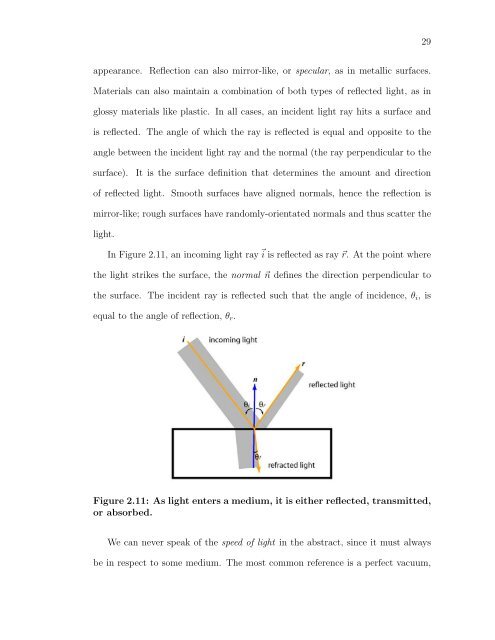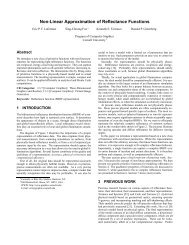- Page 1 and 2: PIGMENTED COLORANTS: DEPENDENCE ON
- Page 3 and 4: ABSTRACT We present a physically ba
- Page 5 and 6: Acknowledgements This work would no
- Page 7 and 8: Table of Contents 1 Introduction 1
- Page 9 and 10: List of Tables 2.1 Average pigment
- Page 11 and 12: 3.15 Photoreceptor absorption .....
- Page 13 and 14: B.15 Variation of spectral reflecta
- Page 15 and 16: corrode the surfaces of materials.
- Page 17 and 18: Figure 1.1: Detail of the Azor-Sado
- Page 19 and 20: However, since mural artwork is typ
- Page 21 and 22: at a very high quality (albeit limi
- Page 23 and 24: heterogeneous sum of very different
- Page 25 and 26: which linseed oil derives (the most
- Page 27 and 28: oration of a rigidly painted layer
- Page 29 and 30: ing will hit the ground and reflect
- Page 31 and 32: tion of paint tubes in 1841 and the
- Page 33 and 34: Figure 2.8: Natural pigments of ant
- Page 35 and 36: ecome more common recently. The Ame
- Page 37 and 38: A V = O(r2 ) O(r3 ) = 1 O(r) 24 (2.
- Page 39 and 40: Table 2.2: Pigment specific gravity
- Page 41: provide the underlying color to a p
- Page 45 and 46: In general, when light travels from
- Page 47 and 48: materials while lit from behind. Li
- Page 49 and 50: Table 2.4: Index of refraction η f
- Page 51 and 52: to completely congeal. Hence, these
- Page 53 and 54: ond together to form proteins. Exam
- Page 55 and 56: to its original state by any means.
- Page 57 and 58: While it has been used since the 19
- Page 59 and 60: organic binder found in more conven
- Page 61 and 62: 3.1.1 Visible Light Spectrum Light
- Page 63 and 64: Figure 3.2: Hue, brightness and sat
- Page 65 and 66: measures how much light is reflecte
- Page 67 and 68: Figure 3.6: Additive color mixing o
- Page 69 and 70: Figure 3.9: The physical amount of
- Page 71 and 72: The vascular tunic lies on the wall
- Page 73 and 74: Figure 3.11: Cross section of the r
- Page 75 and 76: Not all areas have the same sensiti
- Page 77 and 78: identify and distinguish between va
- Page 79 and 80: that range between zero and full in
- Page 81 and 82: spectrum. This insures that the res
- Page 83 and 84: Figure 3.19: Graphical representati
- Page 85 and 86: X x = (X + Y + Z) Y y = (X + Y + Z)
- Page 87 and 88: color into the appropriate RGB colo
- Page 89 and 90: components in the image (the smalle
- Page 91 and 92: haviors of subtractive mixing and i
- Page 93 and 94:
of perceptually equal sizes. Unfort
- Page 95 and 96:
enabling one to transform between t
- Page 97 and 98:
andwidth as converted signals are s
- Page 99 and 100:
Figure 3.28: Retinal ganglion recep
- Page 101 and 102:
example shown in Figure 3.28. Under
- Page 103 and 104:
Figure 3.31: The work of Josef Albe
- Page 105 and 106:
sensations for each trial and picke
- Page 107 and 108:
Chapter 4 Previous Work There is no
- Page 109 and 110:
different location. Subsurface scat
- Page 111 and 112:
describes the scattering and absorp
- Page 113 and 114:
only accounts for a small percentag
- Page 115 and 116:
σ ′ t = σa + σ ′ s and α
- Page 117 and 118:
104 Figure 4.4: A model of an alaba
- Page 119 and 120:
effects or are too computationally
- Page 121 and 122:
108 Figure 4.6: Results using Kubel
- Page 123 and 124:
specifying pigments works adequatel
- Page 125 and 126:
color representation, it is not fea
- Page 127 and 128:
time. A metallic surface patina is
- Page 129 and 130:
the system consisted of wetness and
- Page 131 and 132:
or darkening enables the museum per
- Page 133 and 134:
in front of a displayed work. Felle
- Page 135 and 136:
light exposure. This effect is espe
- Page 137 and 138:
over time. Perceptually, these hues
- Page 139 and 140:
The rate of change of the concentra
- Page 141 and 142:
over white grounds) suffer the grea
- Page 143 and 144:
protects the deeper remaining color
- Page 145 and 146:
light source. This method is used w
- Page 147 and 148:
chemical smog and have been identif
- Page 149 and 150:
Chapter 5 Preparation & Measurement
- Page 151 and 152:
tending transparent pigments used i
- Page 153 and 154:
140 Figure 5.1: Spectral reflectanc
- Page 155 and 156:
the requirements of the work at han
- Page 157 and 158:
144 Figure 5.2: Left: Magnified vie
- Page 159 and 160:
Table 5.2: Relevant data regarding
- Page 161 and 162:
historically one of the best grades
- Page 163 and 164:
created far too strong of a binder,
- Page 165 and 166:
too brittle and cracking. While wor
- Page 167 and 168:
154 Figure 5.4: Reflectance values
- Page 169 and 170:
5.1.5 Painting After the layers of
- Page 171 and 172:
The gray card reflected 18% of the
- Page 173 and 174:
160 Figure 5.8: The optical setup f
- Page 175 and 176:
Note that harmonics reflect at the
- Page 177 and 178:
Note that the calibration factors f
- Page 179 and 180:
Chapter 6 Experimental Results 6.1
- Page 181 and 182:
168 Figure 6.1: Lapis Lazuli in dif
- Page 183 and 184:
(such as CIE standards C, D50, orD6
- Page 185 and 186:
172 Table 6.2: Perceptual differenc
- Page 187 and 188:
174 Figure 6.3: Munsell plots of La
- Page 189 and 190:
and j has a saturation of red rsat,
- Page 191 and 192:
178 Figure 6.4: Variation of spectr
- Page 193 and 194:
visible spectrum are increasing at
- Page 195 and 196:
182 Figure 6.5: Munsell plots of La
- Page 197 and 198:
trying to match color ca from the p
- Page 199 and 200:
as it ages. This is in direct contr
- Page 201 and 202:
teractive viewer. In our applicatio
- Page 203 and 204:
190 Figure 7.1: Our simulated canva
- Page 205 and 206:
where n is the normal at the curren
- Page 207 and 208:
In summary, our implementation prov
- Page 209 and 210:
Chapter 8 Conclusion We have studie
- Page 211 and 212:
inks are beginning to find their wa
- Page 213 and 214:
Appendix A Derivation of K-M theory
- Page 215 and 216:
∆i − =(K + S) idx 202 ∆j −
- Page 217 and 218:
Equation A.8 is now: Rearranging yi
- Page 219 and 220:
and if the paint is infinitely thic
- Page 221 and 222:
One concatenates the layers into a
- Page 223 and 224:
210 Figure B.1: Cold Glauconite in
- Page 225 and 226:
Table B.1: Color conversions from t
- Page 227 and 228:
214 Figure B.4: Munsell plots of Co
- Page 229 and 230:
216 Figure B.5: Burnt Sienna in dif
- Page 231 and 232:
Table B.5: Color conversions from t
- Page 233 and 234:
220 Figure B.8: Munsell plots of La
- Page 235 and 236:
222 Figure B.9: Red Ochre Tint in d
- Page 237 and 238:
Table B.9: Color conversions from t
- Page 239 and 240:
226 Figure B.12: Munsell plots of C
- Page 241 and 242:
228 Figure B.13: Variation of spect
- Page 243 and 244:
230 Figure B.15: Variation of spect
- Page 245 and 246:
Table B.13: Color conversions of Bu
- Page 247 and 248:
234 Figure B.18: Munsell plots of C
- Page 249 and 250:
236 Figure B.20: Munsell plots of R
- Page 251 and 252:
References [Alb71] Josef Albers. In
- Page 253 and 254:
240 [GLL + 04] Michael Goesele, Hen
- Page 255 and 256:
242 [KM31] Paul Kubelka and Franz M
- Page 257 and 258:
[Rat72] Floyd Ratliff. Contour and



